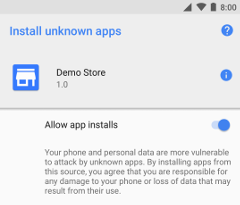एक ओपन प्लैटफ़ॉर्म होने के नाते, Android आपको अपनी पसंद के मुताबिक ऐप्लिकेशन चुनने का विकल्प देता है. आपके पास अपने Android ऐप्लिकेशन को उपयोगकर्ताओं के लिए उपलब्ध कराने के कई तरीके हैं. इसके लिए, अपनी ज़रूरतों के हिसाब से, डिस्ट्रिब्यूशन के किसी तरीके या एक से ज़्यादा तरीकों का इस्तेमाल किया जा सकता है. ऐप्लिकेशन को किसी ऐप्लिकेशन मार्केटप्लेस में पब्लिश करने से लेकर, किसी वेबसाइट से ऐप्लिकेशन उपलब्ध कराने या उन्हें सीधे तौर पर उपयोगकर्ताओं को ईमेल करने तक, आपको किसी खास डिस्ट्रिब्यूशन प्लैटफ़ॉर्म का इस्तेमाल करने के लिए मजबूर नहीं किया जाता.
ऐप्लिकेशन बनाने और उन्हें डिस्ट्रिब्यूट करने के लिए पैकेज करने की प्रोसेस एक जैसी होती है. इससे कोई फ़र्क़ नहीं पड़ता कि उन्हें कैसे डिस्ट्रिब्यूट किया जाता है. इससे आपका समय बचता है और आपको प्रोसेस के कुछ हिस्सों को ज़रूरत के हिसाब से अपने-आप होने वाली प्रोसेस के तौर पर सेट करने की सुविधा मिलती है. ज़्यादा जानकारी के लिए, रिलीज़ की तैयारी करना लेख पढ़ें.
यहां दिए गए सेक्शन में, ऐप्लिकेशन डिस्ट्रिब्यूट करने के कुछ विकल्पों के बारे में बताया गया है.
ऐप्लिकेशन मार्केटप्लेस के ज़रिए ऐप्लिकेशन उपलब्ध कराना
आम तौर पर, ज़्यादा से ज़्यादा ऑडियंस तक पहुंचने के लिए, आपको अपने ऐप्लिकेशन को Google Play जैसे मार्केटप्लेस पर उपलब्ध कराना होगा.
Google Play, Android ऐप्लिकेशन के लिए सबसे बेहतरीन मार्केटप्लेस है. अगर आपको दुनिया भर के लोगों तक अपने ऐप्लिकेशन पहुंचाने हैं, तो यह आपके लिए खास तौर पर फ़ायदेमंद है. हालांकि, आपके पास अपने ऐप्लिकेशन को किसी भी ऐप मार्केटप्लेस के ज़रिए उपलब्ध कराने का विकल्प होता है. इसके अलावा, एक से ज़्यादा मार्केटप्लेस का इस्तेमाल भी किया जा सकता है.
वितरण के अन्य तरीकों के उलट, Google Play पर आपको इन-ऐप्लिकेशन बिलिंग सेवा और लाइसेंसिंग सेवा का इस्तेमाल करने की अनुमति मिलती है. इन-ऐप्लिकेशन बिलिंग सेवा की मदद से, ऐप्लिकेशन में मौजूद प्रॉडक्ट बेचना आसान हो जाता है. जैसे, गेम में इस्तेमाल होने वाले गहने या ऐप्लिकेशन की सुविधाओं को अपग्रेड करना. लाइसेंसिंग सेवा , आपके ऐप्लिकेशन को बिना अनुमति के इंस्टॉल करने और इस्तेमाल करने से रोकने में मदद करती है.
ईमेल के ज़रिए ऐप्लिकेशन डिस्ट्रिब्यूट करना
ऐप्लिकेशन रिलीज़ करने का सबसे आसान तरीका है कि उन्हें ईमेल से उपयोगकर्ताओं को भेजा जाए. इसके लिए, ऐप्लिकेशन को रिलीज़ के लिए तैयार करें, उसे ईमेल में अटैच करें, और किसी उपयोगकर्ता को भेजें. जब उपयोगकर्ता Android डिवाइस पर आपका ईमेल खोलता है, तो Android सिस्टम APK को पहचान लेता है. इसके बाद, वह ईमेल में अभी इंस्टॉल करें बटन दिखाता है. उपयोगकर्ता, बटन को दबाकर आपका ऐप्लिकेशन इंस्टॉल कर सकते हैं. अगर उपयोगकर्ताओं ने पहले से अनजान ऐप्लिकेशन इंस्टॉल करने के लिए ऑप्ट इन नहीं किया है, तो उन्हें ऐसा करना होगा. इसके बाद ही, वे ऐप्लिकेशन इंस्टॉल कर पाएंगे.
अगर आपको कुछ भरोसेमंद उपयोगकर्ताओं को ऐप्लिकेशन भेजने हैं, तो उन्हें ईमेल के ज़रिए भेजना आसान होता है. हालांकि, इससे पायरेसी और बिना अनुमति के डिस्ट्रिब्यूशन से कुछ हद तक सुरक्षा मिलती है. इसका मतलब है कि आपने जिन लोगों को ऐप्लिकेशन भेजे हैं वे उन्हें आसानी से दूसरों को फ़ॉरवर्ड कर सकते हैं.
वेबसाइट के ज़रिए डिस्ट्रिब्यूट करना
अगर आपको Google Play जैसे किसी मार्केटप्लेस पर अपने ऐप्लिकेशन रिलीज़ नहीं करने हैं, तो उन्हें अपनी वेबसाइट या सर्वर पर डाउनलोड के लिए उपलब्ध कराया जा सकता है. इनमें कोई निजी या एंटरप्राइज़ सर्वर भी शामिल है. इसके लिए, सबसे पहले अपने ऐप्लिकेशन को सामान्य तरीके से रिलीज़ के लिए तैयार करें. इसके बाद, रिलीज़ के लिए तैयार APK फ़ाइलों को अपनी वेबसाइट पर होस्ट करें और उपयोगकर्ताओं को डाउनलोड करने का लिंक दें. इस तरह से डिस्ट्रिब्यूट किए गए ऐप्लिकेशन को इंस्टॉल करने के लिए, उपयोगकर्ताओं को अनजान ऐप्लिकेशन इंस्टॉल करने के लिए ऑप्ट-इन करना होगा.
उपयोगकर्ता के पास, अनजान ऐप्लिकेशन इंस्टॉल करने की सुविधा को ऑप्ट-इन करने का विकल्प होता है
Android, उपयोगकर्ताओं को अनजान ऐप्लिकेशन को गलती से डाउनलोड और इंस्टॉल करने से बचाता है. इसके अलावा, यह Google Play के अलावा अन्य सोर्स से डाउनलोड किए गए ऐप्लिकेशन से भी बचाता है. जब तक उपयोगकर्ता, अन्य सोर्स से ऐप्लिकेशन इंस्टॉल करने की अनुमति नहीं देता, तब तक Android ऐसे ऐप्लिकेशन इंस्टॉल करने से रोकता है. ऑप्ट-इन करने की प्रोसेस, उपयोगकर्ता के डिवाइस पर चल रहे Android के वर्शन पर निर्भर करती है:

पहली इमेज: अनजान ऐप्लिकेशन इंस्टॉल करें सिस्टम सेटिंग स्क्रीन. यहां उपयोगकर्ता, किसी खास सोर्स को अनजान ऐप्लिकेशन इंस्टॉल करने की अनुमति देते हैं.
- Android 8.0 (एपीआई लेवल 26) और उसके बाद के वर्शन वाले डिवाइसों पर, उपयोगकर्ताओं को Install unknown apps सिस्टम सेटिंग स्क्रीन पर जाना होगा. इससे वे किसी खास जगह से ऐप्लिकेशन इंस्टॉल करने की सुविधा चालू कर पाएंगे. जैसा कि इमेज 1 में दिखाया गया है.
- Android 7.1.1 (एपीआई लेवल 25) और इससे पहले के वर्शन वाले डिवाइसों पर, उपयोगकर्ताओं को नामालूम स्रोत सिस्टम सेटिंग चालू करनी होगी. यह सेटिंग, उनके डिवाइसों पर सेटिंग > सुरक्षा में जाकर देखी जा सकती है.
दोनों ही मामलों में, उपयोगकर्ताओं को ऑप्ट-इन करने की प्रोसेस पूरी करनी होगी. इसके बाद ही, वे अपने डिवाइसों पर अज्ञात सोर्स से ऐप्लिकेशन डाउनलोड और इंस्टॉल कर पाएंगे.

